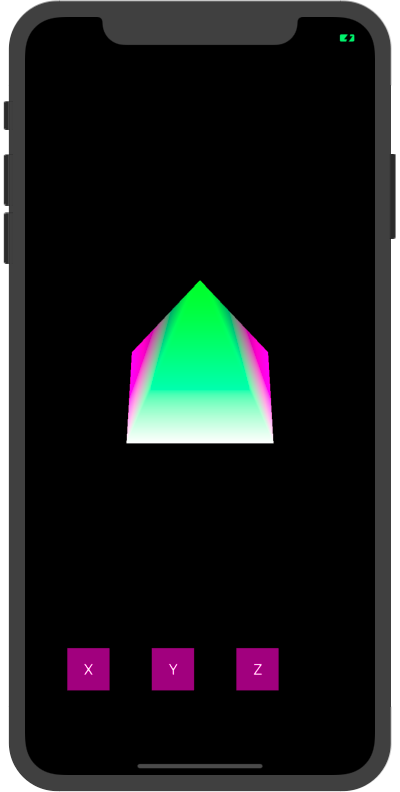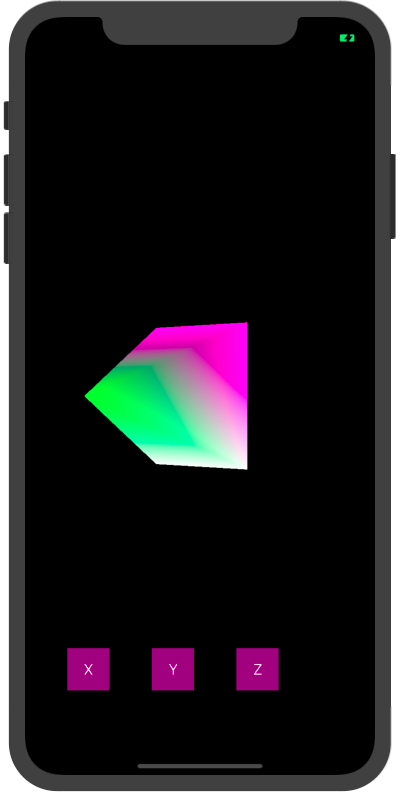- (void)renderLayer
{
//Set window background color
glClearColor(0.0, 0.0, 0.0, 1.0);
//Clear color cache
glClear(GL_COLOR_BUFFER_BIT);
//Set viewport size
CGFloat scale = [[UIScreen mainScreen] scale];
glViewport(self.frame.origin.x*scale, self.frame.origin.y*scale, self.frame.size.width*scale, self.frame.size.height*scale);
//Read vertex and slice shader program
NSString *vertFile = [[NSBundle mainBundle] pathForResource:@"shaderv" ofType:@"glsl"];
NSString *fragFile = [[NSBundle mainBundle] pathForResource:@"shaderf" ofType:@"glsl"];
NSLog(@"vertFile:%@", vertFile);
NSLog(@"fragFile:%@", fragFile);
//judge myProgram Whether it exists, empty if it exists
if (self.myProgram) {
glDeleteProgram(self.myProgram);
self.myProgram = 0;
}
//Load shaders to myProgram in
self.myProgram = [self loadShader:vertFile frag:fragFile];
//create link
glLinkProgram(self.myProgram);
GLint linkSuccess;
//Get link status
glGetProgramiv(self.myProgram, GL_LINK_STATUS, &linkSuccess);
//Judge whether the link is successful
if (linkSuccess == GL_FALSE) {
//Get failure information
GLchar message[256];
glGetProgramInfoLog(self.myProgram, sizeof(message), 0, &message[0]);
//c String to oc Character string
NSString *messageString = [NSString stringWithUTF8String:message];
NSLog(@"error:%@", messageString);
return;
} else {
//Use myProgram
glUseProgram(self.myProgram);
}
//Create a drawing index array
GLuint indices[] = {
0, 3, 2,
0, 1, 3,
0, 2, 4,
0, 4, 1,
2, 3, 4,
1, 4, 3
};
//Determine whether the vertex cache is empty. If it is empty, a cache flag will be applied
if (self.myVertices == 0) {
glGenBuffers(1, &_myVertices);
}
//----------Work with vertex coordinates---------
/*vertex data
1.The first three coordinate values (x, y, z) and the last three color values (RGB);
2.There is an order, otherwise the drawing shape is completely different
*/
GLfloat attrArr[] =
{
-0.5f, 0.5f, 0.0f, 1.0f, 0.0f, 1.0f, //Left upper
0.5f, 0.5f, 0.0f, 1.0f, 0.0f, 1.0f, //Right upper
-0.5f, -0.5f, 0.0f, 1.0f, 1.0f, 1.0f, //Left lower
0.5f, -0.5f, 0.0f, 1.0f, 1.0f, 1.0f, //lower right
0.0f, 0.0f, 1.0f, 0.0f, 1.0f, 0.0f, //vertex
};
//take_myVertices Bound to GL_ARRAY_BUFFER Logo
glBindBuffer(GL_ARRAY_BUFFER, _myVertices);
//Transfer vertex coordinate data from CPU Copy to GPU upper
glBufferData(GL_ARRAY_BUFFER, sizeof(attrArr), attrArr, GL_DYNAMIC_DRAW);
//Passing vertex coordinate data through myProgram Passed to the position
//Get vertex attribute entry
GLuint position = glGetAttribLocation(self.myProgram, "position");
/*Transmit data
1.There are six data in a row, the first three are coordinates and the last three are colors;
2.NULL Start position: 0 by default, pointing to the array first address;
*/
glVertexAttribPointer(position, 3, GL_FLOAT, GL_FALSE, sizeof(GLfloat)*6, NULL);
//Set the appropriate format to read data from the cache
glEnableVertexAttribArray(position);
//Processing vertex color data: passed to the positionColor
GLuint positionColor = glGetAttribLocation(self.myProgram, "positionColor");
glVertexAttribPointer(positionColor, 3, GL_FLOAT, GL_FALSE, sizeof(GLfloat)*6, (float *)NULL +3);
glEnableVertexAttribArray(positionColor);
//stay myProgram Find perspective projection matrix and model view matrix in
GLuint projectionMatrixSlot = glGetUniformLocation(self.myProgram, "projectionMatrix");
GLuint modelViewMatrixSlot = glGetUniformLocation(self.myProgram, "modelViewMatrix");
//Create perspective projection matrix and initialize
float width = self.frame.size.width;
float height = self.frame.size.height;
KSMatrix4 _projectionMatrix;
ksMatrixLoadIdentity(&_projectionMatrix);
float aspect = width/height;
ksPerspective(&_projectionMatrix, 30.0, aspect, 5.0f, 20.0f);
//Set up glsl Projection matrix inside
glUniformMatrix4fv(projectionMatrixSlot, 1, GL_FALSE, (GLfloat *)&_projectionMatrix.m[0][0]);
//Enable rejection function
glEnable(GL_CULL_FACE);
//To create a translation matrix: Z Axis translation-10
KSMatrix4 _modelViewMatrix;
ksMatrixLoadIdentity(&_modelViewMatrix);
ksTranslate(&_modelViewMatrix, 0.0, 0.0, -10.0);
//Create rotation matrix
KSMatrix4 _rotationMatrix;
ksMatrixLoadIdentity(&_rotationMatrix);
ksRotate(&_rotationMatrix, xDegree, 1.0, 0.0, 0.0);
ksRotate(&_rotationMatrix, yDegree, 0.0, 1.0, 0.0);
ksRotate(&_rotationMatrix, zDegree, 0.0, 0.0, 1.0);
//Multiply the translation matrix and rotation matrix, and put the result into the model view matrix
ksMatrixMultiply(&_modelViewMatrix, &_rotationMatrix, &_modelViewMatrix);
//Set up glsl Model view matrix inside
glUniformMatrix4fv(modelViewMatrixSlot, 1, GL_FALSE, (GLfloat *)&_modelViewMatrix.m[0][0]);
//Set drawing parameters: slice element, number, index array
glDrawElements(GL_TRIANGLES, sizeof(indices)/sizeof(indices[0]), GL_UNSIGNED_INT, indices);
//Render the data in the cache to the display layer by vertex shaders
[self.myContext presentRenderbuffer:GL_RENDERBUFFER];
}

